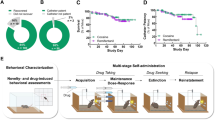Abstract
In this chapter, the pharmacological factors involved in predicting the abuse liability of drugs are discussed with major emphasis on their psychological dependence potential. For prediction of drug abuse liability, it is important to find and compare the drug’s effects against those of prototypic drugs. The important pharmacological properties include the following: central nervous system (CNS) effects, including operant behavioral effects; tolerance; physical dependence potential; and psychological dependence potential. It is also important to consider such chemical and pharmacokinetic properties as water solubility and speeds of absorption and elimination. In particular, psychological dependence potential is most relevant to abuse liability. To evaluate psychological dependence potential from animal studies, the reinforcing and discriminative stimulus properties of drugs must be assessed in comparison with those of prototypic drugs. When human data are available, it is important to verify the animal results on such points as pharmacokinetics and CNS drug susceptibility which may differ across species.
Special consideration should also be given to the following in evaluating psychological dependence potential from animal studies: differences in reinforcing effects depending on the experimental procedure used, analysis of reinforcement data obtained in intragastric self-administration, daily dose and CNS manifestation in self-administration experiments, and influence of physical dependence. From a practical viewpoint, it is also important to predict the nature and extent of ill effects which arise as a consequence of abuse. For this, such drug properties as the CNS effects, psychological dependence potential, toxicity, tolerance, and physical dependence potential must be considered.
Access this chapter
Tax calculation will be finalised at checkout
Purchases are for personal use only
Preview
Unable to display preview. Download preview PDF.
Similar content being viewed by others
References
Brady, J. V., & Griffiths, R. R. (1983). Testing drugs for abuse liability and behavioral toxicity: Progress report from the laboratories at the Johns Hopkins University School of Medicine. In L. S. Harris (Ed.), Problems of drug dependence, 1982 (National Institute on Drug Abuse Research Monograph 43, pp. 99–124). Washington, DC: U.S. Government Printing Office.
Deneau, G., Yanagita, T., & Seevers, M. H. (1969). Self-administration of psychoactive substances by the monkey: A measure of psychological dependence. Psychopharmacologia, 16, 30–48.
United Nations (1977). Convention on psychotropic substances, 1971. New York: United Nations.
WHO Expert Committee on Drug Dependence. (1969). World Health Organization technical report series (No. 407).
Yanagita, T. (1976). Some methodological problems in assessing dependence-producing properties of drugs in animals. Pharmacological Reviews, 27, 503–509.
Yanagita, T. (1977). Brief review on the use of self-administration techniques for predicting drug dependence potential. In T. Thompson & K. R. Unna (Eds.), Predicting dependence liability of stimulant and depressant drugs (pp. 231–242). Baltimore: University Park Press.
Yanagita, T., Ando, K., Kato, S., & Takada, K. (1983). Psychopharmacological studies on nicotine and tobacco smoking in rhesus monkeys. Psychopharmacology Bulletin, 19(3), 409–412.
Yanagita, T., Ando, K., Oinuma, N., & Ishida, K. (1974). Intravenous self-administration of nicotine and an attempt to produce smoking behavior in monkeys. Committee on Problems of Drug Dependence, 567–578.
Yanagita, T., & Kato, S., (1983). Dependence studies on zopiclone. In L. S. Harris (Ed.), Problems of drug dependence, 1982 (National Institute on Drug Abuse Research Monograph 43, pp. 164–170). Washington, DC: U.S. Government Printing Office.
Yanagita, T., Miyasato, K., & Sato, J. (1980). Dependence potential of loperamide studied in rhesus monkeys. In L. S. Harris (Ed.), Problems of drug dependence, 1979 (National Institute on Drug Abuse Research Monograph 27, pp. 106–113). Washington, DC: U.S. Government Printing Office.
Author information
Authors and Affiliations
Editor information
Editors and Affiliations
Rights and permissions
Copyright information
© 1987 Springer-Verlag New York Inc.
About this chapter
Cite this chapter
Yanagita, T. (1987). Prediction of Drug Abuse Liability from Animal Studies. In: Bozarth, M.A. (eds) Methods of Assessing the Reinforcing Properties of Abused Drugs. Springer, New York, NY. https://doi.org/10.1007/978-1-4612-4812-5_10
Download citation
DOI: https://doi.org/10.1007/978-1-4612-4812-5_10
Publisher Name: Springer, New York, NY
Print ISBN: 978-1-4612-9163-3
Online ISBN: 978-1-4612-4812-5
eBook Packages: Springer Book Archive




